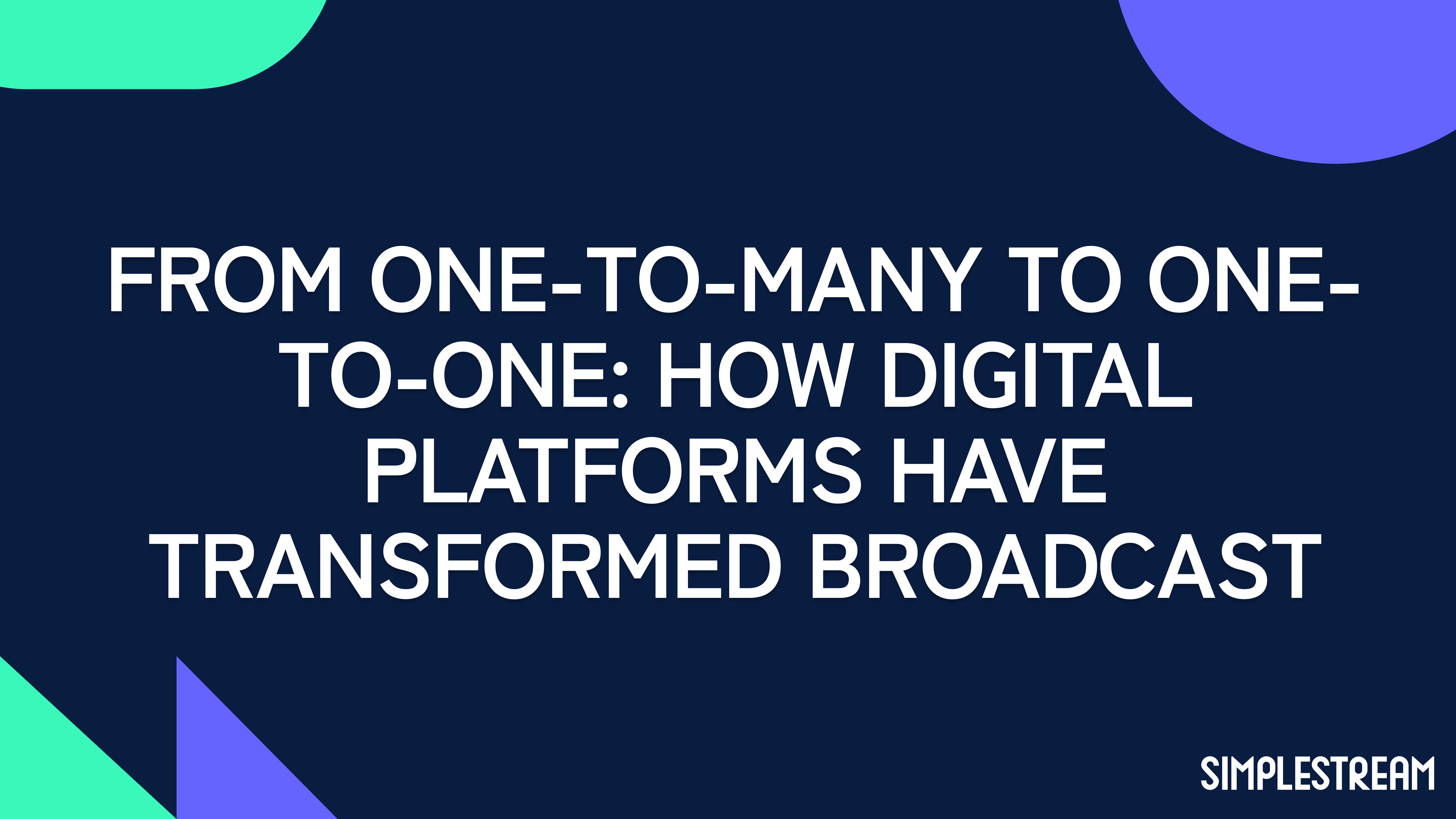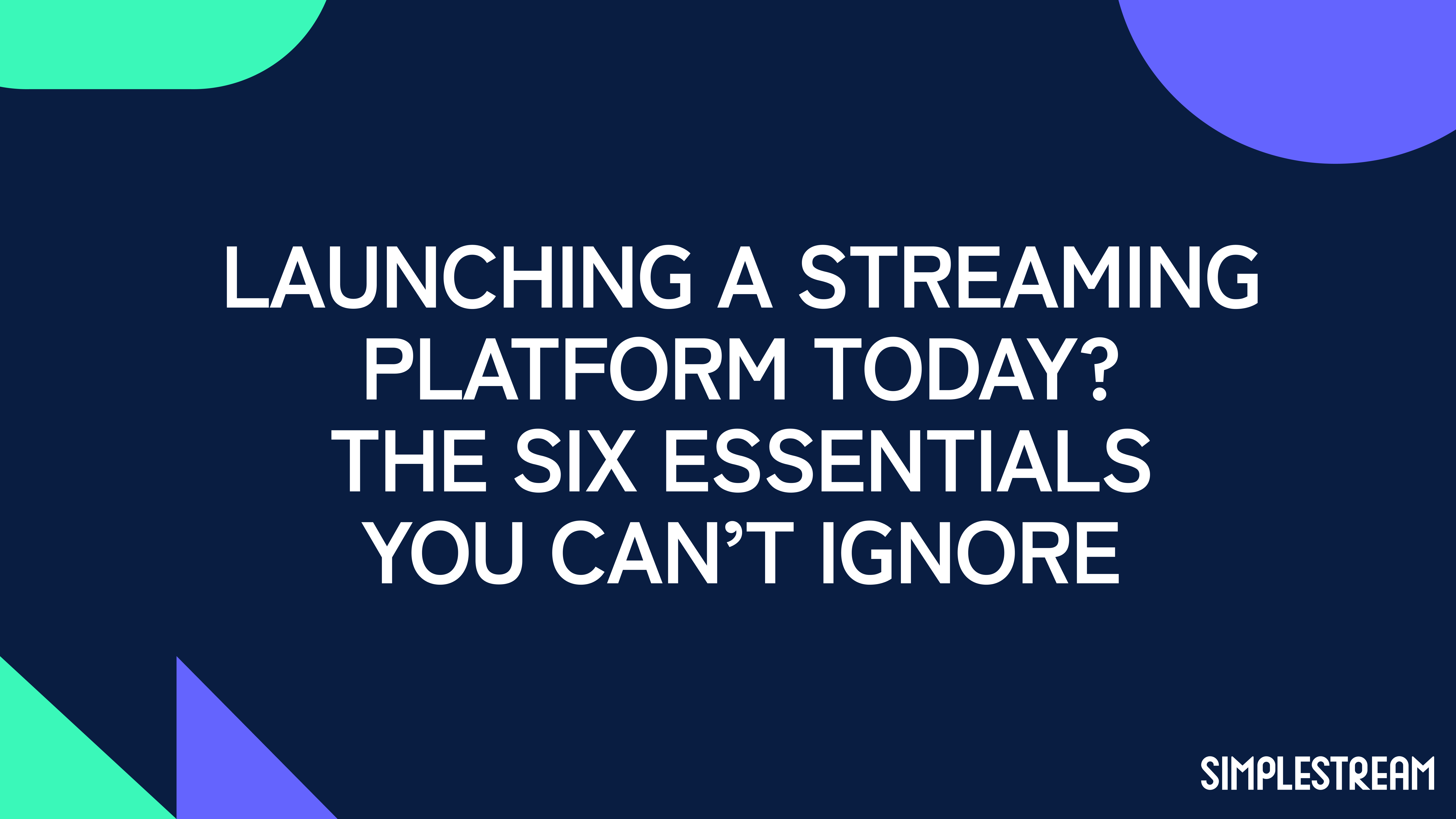How to start a successful OTT streaming service like Netflix and Disney+
How do you create your own Netflix? Find out in 5 steps, from content to choosing the correct business model.
1. Put content at the heart
2. Presentation matters: curate every little detail
3. Simplify your architecture
4. Go to market: choose the right business model and advertising
5. Own your audience with real-time analytics
How do you start a streaming service like Netflix and Disney+?
It’s a billion-dollar question. The over-the-top (OTT) market was valued at $121.6 billion in 2019 and is projected to reach $1,039.03 billion by 2027, a truly staggering number. Taking a slice of this addressable market is more than just ‘build it, and they will come’ – those halcyon days are over. The most popular services are at the forefront of content, UX and UI design, and monetisation models. Though many giants are ahead of the curve, there’s no reason you can’t start a streaming service like Netflix and Disney+, from scratch, today.
How do you battle behemoths in the OTT industry when starting from the bottom? David had a slingshot when he faced Goliath, and your slingshot should be an experienced tech partner.
In this guide, we’ll show you how to launch your own streaming service successfully, including monetisation through subscriptions, advertising models, UX and UI design, and how to manage your content. Whether you’re starting from scratch or updating your existing service and looking for a new tech partner to help, this guide will cover everything you need.
Launch in as little as 12 weeks with Simplestream

#1. Put content at the heart
Customer-centricity is paramount
It’s not about you, it’s about your audience. Who does your content appeal to and relate to? Understanding this aspect is key to building a great library of content and marketing your service to the relevant demographic. Going direct-to-consumer can grant brand clarity and control, reduced time to market, and direct business intelligence. Each of the mentioned points can generate competitive advantage.
Your video library and its metadata
Having your content assets organised and categorised by the relevant metadata will make life much easier when it comes to ingesting it into a Content Management System (CMS). Failing to categorise your content can lead to a significant hurdle to overcome when you attempt to distribute it.
Think about your content as a physical library of books, without the library it’s a disorganised batch of paper. These books should be organised on dedicated shelves by their type and theme, labelled in a system that you understand, making it easy to find exactly what you’re looking for. Media Manager, Simplestream’s modular backend to manage content for distribution, can provide you with the perfect library and a UI that makes it easy to automate the distribution of your video assets.
#2. Presentation matters: curate every little detail
Playlists and automation
You’ve got your content, organised your metadata, and ingested it into your CMS. Your next actions should focus on how you want to display your video assets. Whether it’s movies, tv-series, documentaries, or reality tv, you can place your items into playlists to group them together. This can be done manually for specific titles (after all, who wants Peppa Pig in the same category as Deadliest Catch?), or through dynamic playlists.
Dynamic playlists give you the option of setting up a rule to group your content for presentation in your applications, like a top ten most popular titles carousel. You can do all of this within Media Manager, making simple work of the presentation of your content.
.png)
Apps built with a design-first approach
Your applications are the shopfront of your OTT service, where your UI and UX intersect. How you display your content, and the usability of your streaming service can make or break your business. This is where a design-first approach is essential to making a lasting impression when your viewers use your applications and a good one at that.
Working with a tech partner that has experience in creating applications for numerous sectors and verticals for a range of audience demographics could provide you with the experience required to successfully launch your service. Simplestream’s ethos is driven by a design-first approach that supports the customer from idea inception to the deployment of branding and imagery within the set of applications.
App Platform is the out-of-the-box product that gets your service on the most popular platforms and devices. It comes with capabilities for full customisation: from colours to icons, to CTA buttons and imagery. Create a consistent experience for your viewers at all touch points, regardless of their device or devices of choice by incorporating your branding and imagery. Whether you’re presenting content in landscape or portrait format, or you need channel logos overlayed and series or catch-up data, these are all configurable options with Media Manager.
The presentation of your content in your applications is integral to your service’s success. You want your audience to find content easily without risking drop-off as a result of decision fatigue or a frustrating navigation experience.
%20(1).png)
#3. Simplify your architecture
Build or buy?
The first question you should ask yourself when creating applications for your streaming service is whether you build the applications yourself or outsource this. It can be very costly to develop proprietary apps for every platform and device, not to mention the lengthy process. During this time, a competitor could have used an out-of-the-box solution from an experienced tech partner and beaten you to market.
Another element to consider is how many platforms and devices you need to develop these applications for, as device fragmentation makes this far more complex. In the time that you’ve spent developing proprietary applications, they may also look dated by the time you are ready to release them.
.png)
Multiple devices
Having your streaming service available across a plethora of devices, whether on mobile devices or big screens, is a must. Depending on the type of content your service provides, your audience’s viewing habits may differ by device and viewing method.
You don’t need to be on every platform. However, your applications should be available where your customers are. If you were to look for your favourite brand of a product while completing your weekly shop and it’s not stocked in that store, would you not just pick up the nearest equivalent rather than going to another store to look for it? Leveraging an out-of-the-box set of tried and tested applications for the most popular platforms and devices is the safest choice, and you can find this at Simplestream, with App Platform.
.png)
Delivery at scale
You’ve launched your service on iOS and Android, but you want to expand to big-screen applications to reach more viewers. If you have an audience of hundreds, thousands, or even millions of users, your tech partner of choice should be able to scale with you. The last thing you want is to be held back when there is opportunity, leaving revenues on the table and losing out to your competition.
Simplestream can make your content available immediately across all device platforms with encoding and normalisation completed instantly upon ingesting from any source at scale. You can also transcode your content simply and reliably, making distribution seamless.
.png)
Rights & Regions
What territory are you launching in? What platforms are you going to invest in?
Detailed knowledge of where and on what platforms you should launch your streaming service is paramount. The more regions, countries, and languages you cover, the higher the cost. Let alone the different preferences – on a per country basis – when it comes to platforms and devices. Make sure you understand the specific, regional market, before you activate your go-to-market strategy.
.png)
Multi-regional distribution means higher costs and more complex content management workflows
When purchasing licensed content from third-party content owners, you are provided with a list of regions within which you can distribute it. Having the ability to specify the territories in which your content is being distributed is a must, and it needs to be part of a simplified operation within your CMS. Media Manager allows to group countries into regions, which means you can segment your content seamlessly, and not necessarily by individual countries.
As an example, you could have ‘region 1’ set up as the UK and USA, rather than having to include each individual country code for the countries within those territories, you select ‘region 1’ when surfacing that content. Keeping your service compliant with content rights has never been more efficient.
.png)
Integrations
If you thought about building your OTT or streaming service like renovating a house, you probably wouldn’t want a builder to come into the project and completely remove all the progress that you’ve already made, unless the previous builder subjected you to shoddy workmanship. You may already have a fantastic set of applications, but perhaps a content management system (CMS) that’s lacking in certain features you really need.
When introducing this builder to your existing product, would you want them to pull up the foundations, taking the applications – the roof and walls of your OTT service – down with them as they do? This is exactly why your technology partner should be comfortable integrating with your existing technology stack or other third parties, rather than completely rebuilding it from scratch, just because one element doesn’t work.
#4. Go to market: choose the right business model and advertising
Marketing and promotion
Once you have your applications you also need to be able to promote your content to your audience in-app. Promotion can be done in a number of ways, from in-app banners or pop-ups to featured carousels.
Have a new title you’d like to promote to your audience? Add it to your featured carousel so that it’s front and centre for your viewers when they access your application.
What about a one-off live event or premium transactional video-on-demand (TVOD) option that you’d like to showcase? Create a promotional in-app pop-up with App Platform’s Promo UI feature to market this to your audience. With Promo UI functionalities, you can deploy branded messages at various trigger points across your applications. Whether you want to capture unregistered users or those who log in for the first time, there is a range of options and triggers for your promotional messaging.
.png)
Choosing the ideal business model
Beyond putting your content in playlists, is how you monetise it. You can either place it all together under a subscription model (SVOD) or even a hybrid one with some titles available as a transactional (TVOD) purchase.
SVOD models offer a consistent revenue stream from your users, either through monthly or annual payments. This can also work well if you are using licensed material, and you pay based on usage. Tracking the usage can also be achieved easily with an insights and analytics integration, making it simple to report usage accurately on your licensed content.
The landscape is very competitive – especially as users are bombarded with subscription plan offers on a daily basis – so it’s especially important that the quality of your content is to keep users glued to their screens. You may not be looking at having a large volume of video content, or possibly just one-off live events, in which case pay-per-view (PPV) may be a better business model for your service and content offering.
Freemium subscription tiers are also becoming increasingly popular as these offer subscribers a cheaper service in return for viewing ads. Netflix, Disney+, Hulu, HBO Max, and Paramount+ all have ad-supported packages set to launch soon.
For any of these models, authentication is required for users to set up an account and make a purchase. A frictionless workflow makes the difference between a user completing a transaction or not. After all, nobody likes a drop-out right at the checkout.

Free and ad-supported
The explosion of ad-supported video-on-demand (AVOD) has been making quite a lot of noise, recently, with reporting showing that 1.51 million streaming service subscriptions were cancelled in Q1 of 2022. It’s no surprise that many of the largest SVOD providers were looking at the billion-dollar market of AVOD as a potential answer to this uptick in churn.
AVOD streaming services provide the least number of barriers to entry from the viewer's perspective: no personal details, no accounts to be created, no entry costs, and they can start watching immediately.
Advertising
It’s key for operators to learn – quickly and effectively – how to use adverts on a streaming service to generate revenue from them. Revenue from adverts is based on Cost Per Mille (CPM), the amount you get paid per 1,000 ad views, commonly referred to as “impressions”.
Monetisation through advertising is made possible by an ad server that requests the ads and starts generating revenue based on the CPM the ads return. Simplestream can provide existing integrations with some of the most popular ad servers including Google Ad Manager, SpringServe, FreeWheel, and SuperAwesome. Bespoke integrations for pre-existing ad servers or other third parties of choice are also possible.
.png)
Ad types
- Pre-roll ads play before your content starts and don’t require ad markers to trigger them to play.
- Mid-roll ads go in the middle of your content and require ad markers to trigger them to play.
- Ad pods are pods of ads that you signify by placing ad markers in your content, these are measured by duration and the number of ads that can play in that time.
When you place ad markers in your content, the marker you set is based on duration (time slot) rather than on impressions (number of ads in the time slot). To calculate a projection of how many ads you may have in your content and get an idea of how many ‘impressions’ you can generate per month, you would take the average playtime per user and the number of ads you’re serving in that time, multiplied by the average plays in a month.
Calculate your potential ad revenue with our interactive calculator below ⬇️

SSAI or CSAI?
Server-side or client-side? When it comes to deciding on the best delivery method for your ad-supported OTT service, there’s a lot to consider.
Server-side ad insertion (SSAI): ads are stitched directly into the stream, and they play out almost exactly like traditional broadcast channel ad breaks. It’s seamless, as the viewer isn’t waiting for the ad to load. This method does not require a software development kit (SDK) specific to the device the ad is being inserted on, as it’s a codeless integration.
Client-side ad insertion (CSAI) is slightly different in that the content and ads are not stitched together. From the viewer’s perspective, the player will switch between the content and ads, and this change will be noticeable as the content they’re viewing will pause before the ads begin playing. With client-side, the ads are being inserted by code on the device itself.
Regardless of your preferred method of ad insertion – with benefits on both sides of the spectrum – the adverts will always be targeted and relevant to your viewers. This is a key aspect when compared to traditional broadcast channel ad slots, where you can’t be certain about who is watching, and it’s also the reason you can generate a higher CPM with better targeting and minimum waste. If you know who’s watching, you’ll be at a vantage point, able to tailor the experience to the individual.

#5. Own your audience with real-time analytics
A captain wouldn’t leave port in their ship without a functioning compass. Equally, you shouldn’t launch a streaming service without access to your viewer data analytics. How do you improve your content, UI, and UX, without knowing your viewers’ consumption habits inside out? Simplestream provides real-time insights and analytics so that you can make informed decisions, based on content and viewer behaviour. Taking full advantage of a robust set of data analytics is the difference between a successful streaming service and a failing one.
Simplestream’s data analytics integration provides you with insights into audience preferences, behaviours, content performance, system, platform, and device-specific performance, active user metrics, and much more. Make business decisions with rich data at hand – What are your most popular titles? Which platforms have the largest audience size? When do users access your service?
Your data is shown in real-time with the ability to build bespoke reports dependent on your needs, as this becomes key where reporting on licensed content usage is a requirement for third-party content owners.
Post-launch
You’ve done the hard work, got your content, picked your business model, and built your apps. Now it’s time to sit back and let your viewers enjoy the fruits of your labour, right? Unfortunately, no.
Continual improvement and evolution of your business are how you’ll grow your OTT or streaming service to the heights of Disney+ and Netflix. Taking the information collected from the data and analytics integration you’ve built into your service; helps you build the roadmap for success. Many of our current customers are now seeing an increase in linear viewing habits, with some reporting nearly double the average viewing time when compared to on demand.
Simplestream’s latest product – Channel Studio - allows operators to easily create virtual ‘live’ channels with a simple drag & drop interface, in the cloud. You could create a FAST channel in as little as six steps or a Virtual channel in five.
.png)


